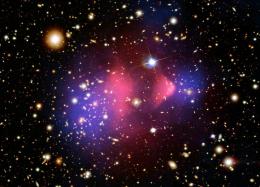C reative
Particle
Higgs
CPH Theory is based on Generalized light velocity from energy into mass.
CPH Theory in Journals
|
Possible Fifth Force Would Make Direct Detection of Dark Matter Unlikely
|
|
By Lisa Zyga
In this image of the Bullet Cluster, the blue area shows what is thought to be dark matter. Physicists are investigating connections between a possible fifth force and the direct detection of dark matter. Image source: NASA / CXC / CIA / STSci / Magellan / Univ. of Ariz. / ESO. (PhysOrg.com) -- No one knows exactly what a “fifth force” might be, but studies have shown that, if a long-range fifth force does exist, it could have surprising effects on the universe’s structure formation. A fifth force could reduce discrepancies between theory and observation in several areas of cosmology. Now, as new research has shown, a fifth force could also be connected to dark matter. In a paper published in Physical Review Letters, physicists Jo Bovy and Glennys Farrar were surprised to discover that a fifth force in the dark sector could place constraints on dark matter that essentially exclude its direct detection through spin-independent interactions. Conversely, if future experiments do detect a spin-independent interaction of dark matter, then any fifth force in the dark sector must be so weak as to be astrophysically irrelevant. “Our study shows that we can strongly constrain some properties of dark matter, i.e., the combination of its interaction with the visible sector and the strength of a long-range fifth force between dark matter particles, through experiments with ordinary matter,” Bovy, a Ph.D. student at New York University, told PhysOrg.com. As for which scenario appears to be more likely - a fifth force excluding direct detection of dark matter, or direct detection of dark matter excluding a relevant fifth force - Bovy and Farrar said that it’s impossible to say in advance. “Both would be very interesting both theoretically as well as observationally,” Bovy said.
Previous research has suggested the possibility that a new
long-range, attractive fifth force might exist, which arises in
several extensions of the standard model. Although most dark
matter models predict that the force between dark matter
particles is a short-range force, other models such as supersymmetry and
string theory allow for the existence of a very light boson
which could carry a long-range force in the dark sector. In the current study, the theorized fifth force - a nongravitational, long-range attractive force - would couple directly to dark matter but not to ordinary visible matter. However, if dark matter particles interacted nongravitationally with ordinary matter, quantum corrections would make the fifth force emerge in the visible sector, as well. This quantum correction occurs when two virtual dark matter particles are coupled to both the fifth force scalar and to two quarks. “Our study reveals a hitherto unrecognized connection between dark matter interactions with ordinary matter, and dark matter self-interactions,” said Farrar, a physics professor and Director of the Center for Cosmology and Particle Physics at New York University. As Bovy and Farrar explain in their study, in order to be astrophysically relevant (i.e., on the order of the gravitational force), the fifth force carrier must have a vacuum expectation value on the order of the Planck mass. In turn, this requires that dark matter be very heavy in most scenarios. In direct detection experiments, scientists look for dark matter by observing ordinary matter particles recoiling due to being scattered by dark matter particles. As the mass of dark matter particles increases, the bounds on the coupling of dark matter and quarks become more stringent, making the direct detection of dark matter more difficult. Besides its implications on the direct detection of dark matter, a fifth force has also been hypothesized to impact large-scale structure formation. If a fifth force was attractive and had a very long range, it would effectively increase the strength of gravitational interaction, and thus accelerate structure formation. As previous studies have shown, such a force could reduce discrepancies between observations and predictions in several areas, such as by increasing the number of galaxy clusters and superclusters and reducing voids, which would agree better with observations. As the scientists explain, the impacts of a possible fifth force do not demand its existence, but they do motivate researchers to explore the implications of a fifth force. “Jo Bovy and I are looking at what the analogous constraints are, between possible dark matter annihilation signals (searched for by Fermi-GLAST and other satellite experiments like PAMELA and ATIC) and a fifth force,” Farrar said. “Also, in collaboration with others, I'm studying the effects of a long-range dark matter force on cosmology and attempting to improve constraints on it from the Bullet cluster.” Bovy added that he’s also investigating the implications of short-range attractive forces between dark matter particles, which may enable the detection of dark matter annihilation from satellite galaxies of the Milky Way. More information: Bovy, Jo and Farrar, Glennys R. “Connection between a Possible Fifth Force and the Direct Detection of Dark Matter.” Physical Review Letters 102, 101301 (2009).
Source: http://www.physorg.com/news157292373.html
1 2 3 4 5 6 7 8 9 10 Newest articles
|
|
Sub quantum space and interactions from photon to fermions and bosons |
Interesting articles
Since 1962 I doubted on Newton's laws. I did not accept the infinitive speed and I found un-vivid the laws of gravity and time.
I learned the Einstein's Relativity, thus I found some answers for my questions. But, I had another doubt of Infinitive Mass-Energy. And I wanted to know why light has stable speed?

